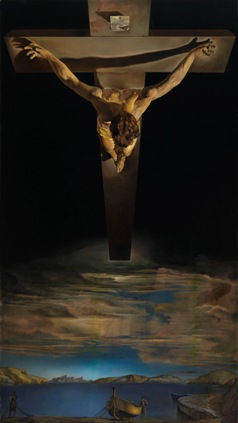
Salvador Dali, Christ of Saint John of the Cross, credit Wikimedia
Special Review by Stuart Millson of Handel’s Messiah, at the Church of St. James the Great, East Malling, Kent
The Bach B minor Mass, Haydn’s The Creation and Handel’s Messiah are probably the best-known choral works of the 18th century: towering pieces, whose religious certainty matches the very stone arches and stained-glass glory of the cathedrals and churches for which they were composed. Yet Messiah received its first performance (13th April, 1742) not in Westminster Abbey but in the Great Music Hall in Fishamble Street, Dublin; a secular setting for a work of exalted valleys, highways through deserts, the glory of the Lord, the Prince of Peace. However, 281 years later ~ this time in mid-Kent ~ Handel’s masterpiece echoed through the impressive space and acoustic of the Norman/early-mediaeval church of St. James the Great, East Malling; performed by the nearly-80-strong village choral society, the East Malling Singers ~ buttressed by a superb array of top-rate visiting soloists, plus a trumpeter and organist.
For months prior to the concert, intensive rehearsals were held under the baton of Music Director, Ciara Considine, with piano accompanist, John Hayden, helping to keep the choral singing together ~ John (with his stylish, characterful playing) being the next best thing to a baroque orchestra. Ciara Considine is a musician of great imagination, who sees her ensemble not just as budding amateurs, but as true, fellow-musicians who are capable of entering into the territory of professional choirs and the great works by the old masters. To this end, Ciara brought to the East Malling rehearsals interpretive touches associated with some of the finest baroque recordings of Messiah: for example, an emphatic staccato effect in the great chorus And the glory of the Lord ~ at the point where the words, ‘The Prince of peace’ conclude a particularly moving, cumulative flow of Handelian authority.
And yet this dedicated conductor did not, in the end, see or hear the fruits of her (and the choir’s) labours: the scourge of Covid preventing the artist from presiding over a masterful realisation of the score. On the day, the final rehearsal and concert was conducted by the previous Principal Conductor, Benjamin Rous, now Head of Music at the prestigious Sussex school, Roedean. With a ready-made performance in his hands, Mr. Rous nevertheless had just enough time to imprint some of his own ideas: such as the line, ‘honour and glory, and blessing’ in the final Worthy is the lamb, sung in such an emphatic, broad way, that the audience probably really did believe that they were receiving a personal benediction.
It is inevitable in any amateur performance that technical imperfections will occur: the occasional slip, momentary or nervous loss of concentration, or cue. Yet overall, in the broad acoustic of the choir’s Kent church; with the singers committed to honouring this glorious oratorio, nobody could possibly doubt the general artistic quality and professional-sounding togetherness of the ensemble. Herewith a roll-call of honour for Gillian Ramm, soprano; Rachael Lloyd, mezzo-soprano; Christopher Fitzgerald-Lombard, tenor; trumpeter Sam Lewis and organist Nick Bland ~ whose masterful control and often bouncy baroque tempo added greatly to the authenticity of this memorable performance.
Stuart Millson is the Classical Music Editor of The Quarterly Review
Like this:
Like Loading...

